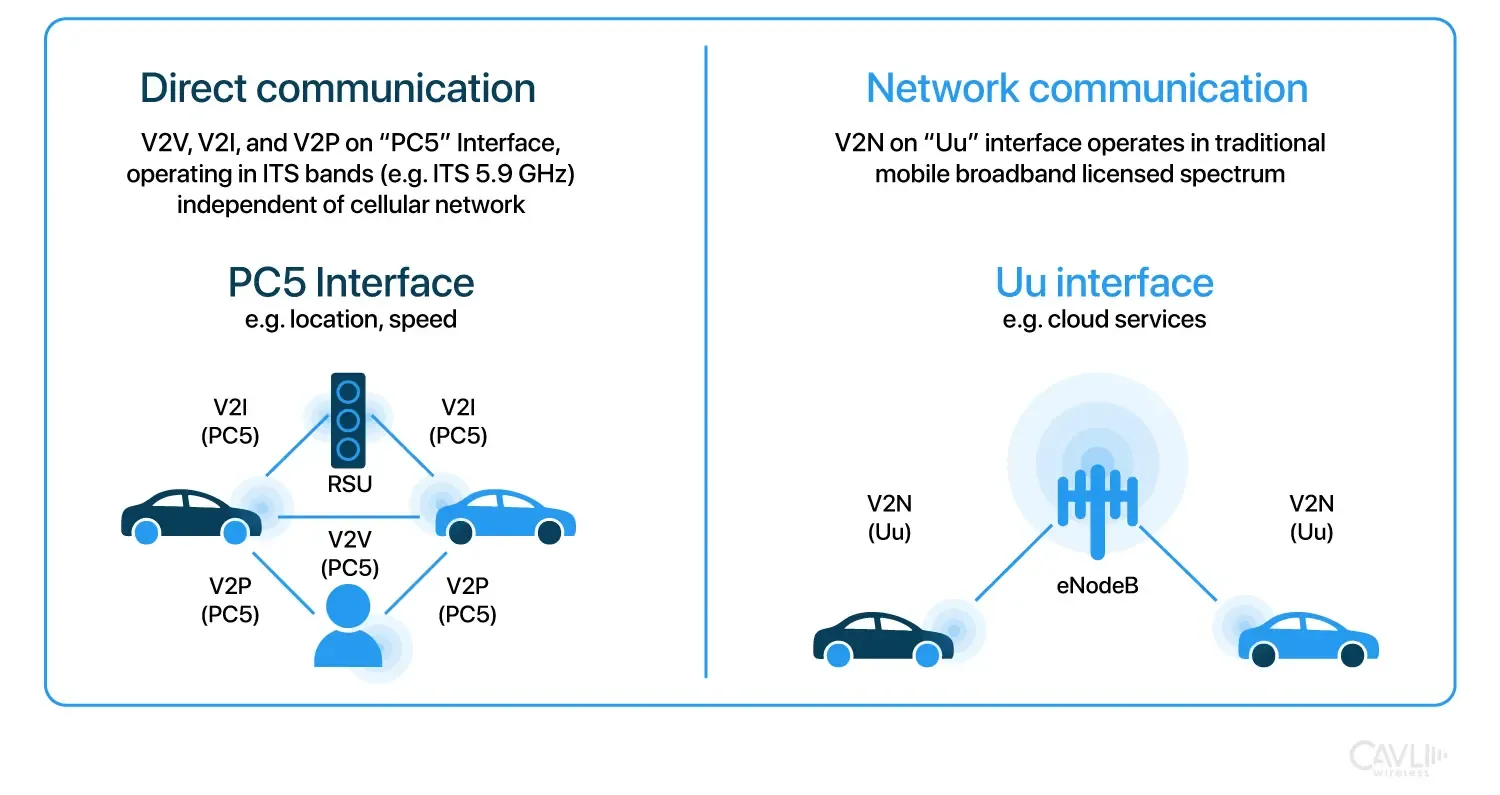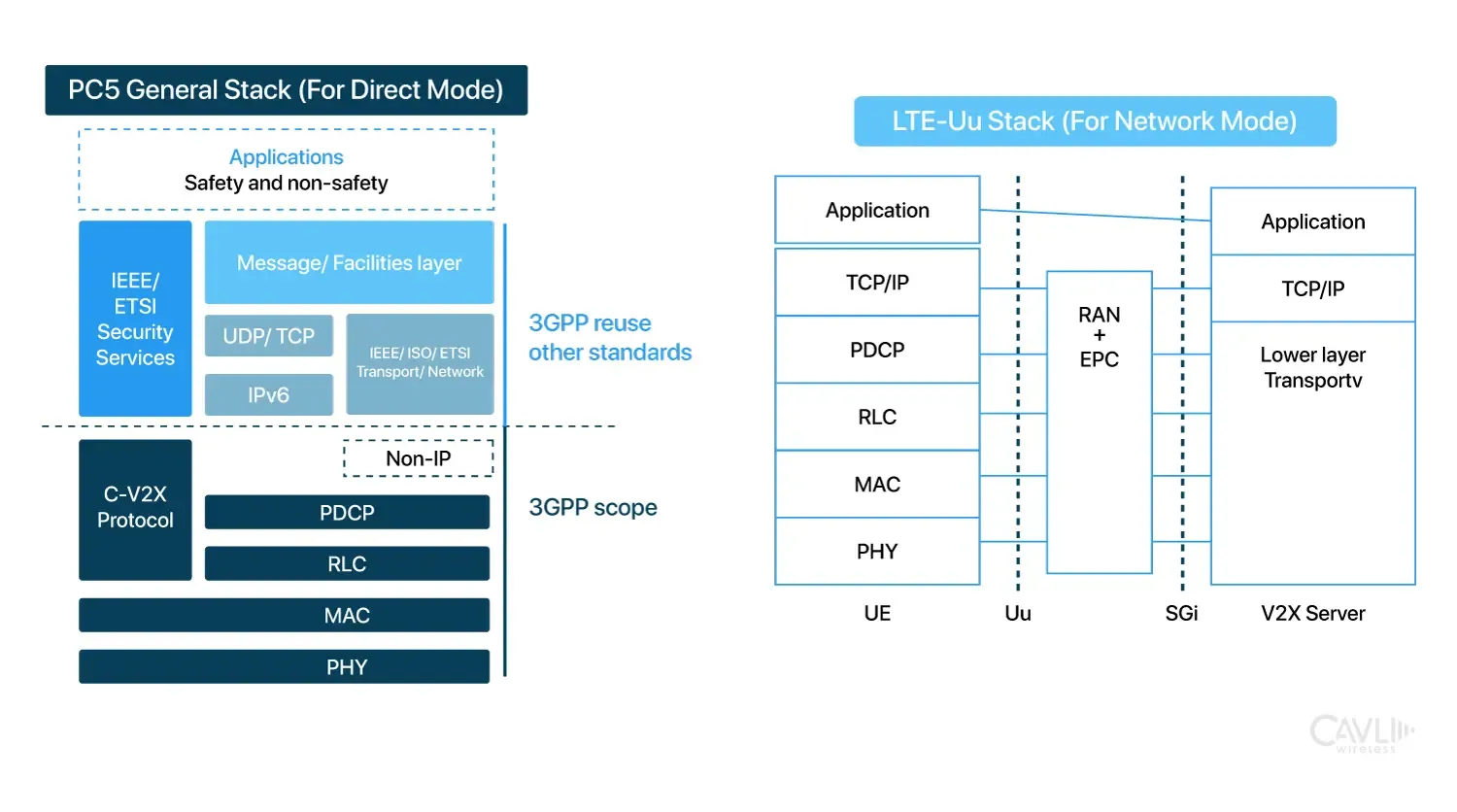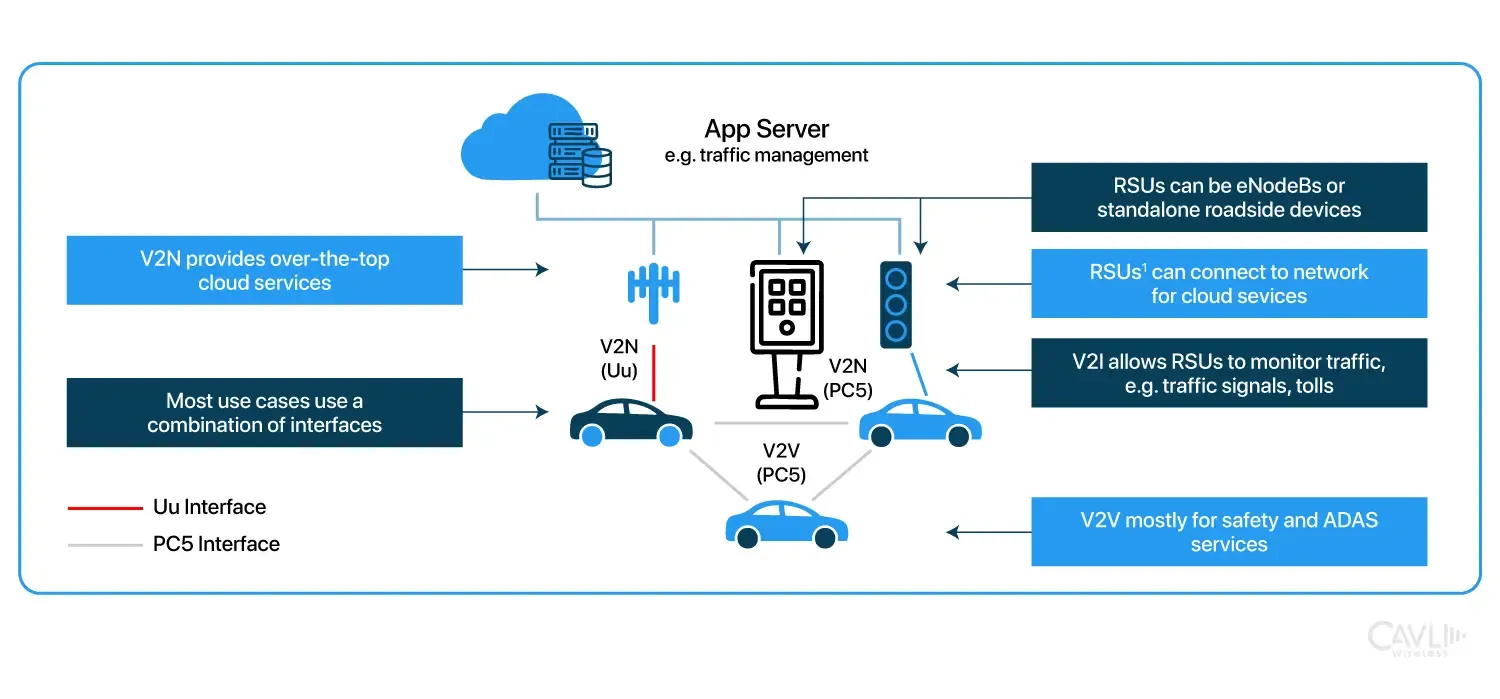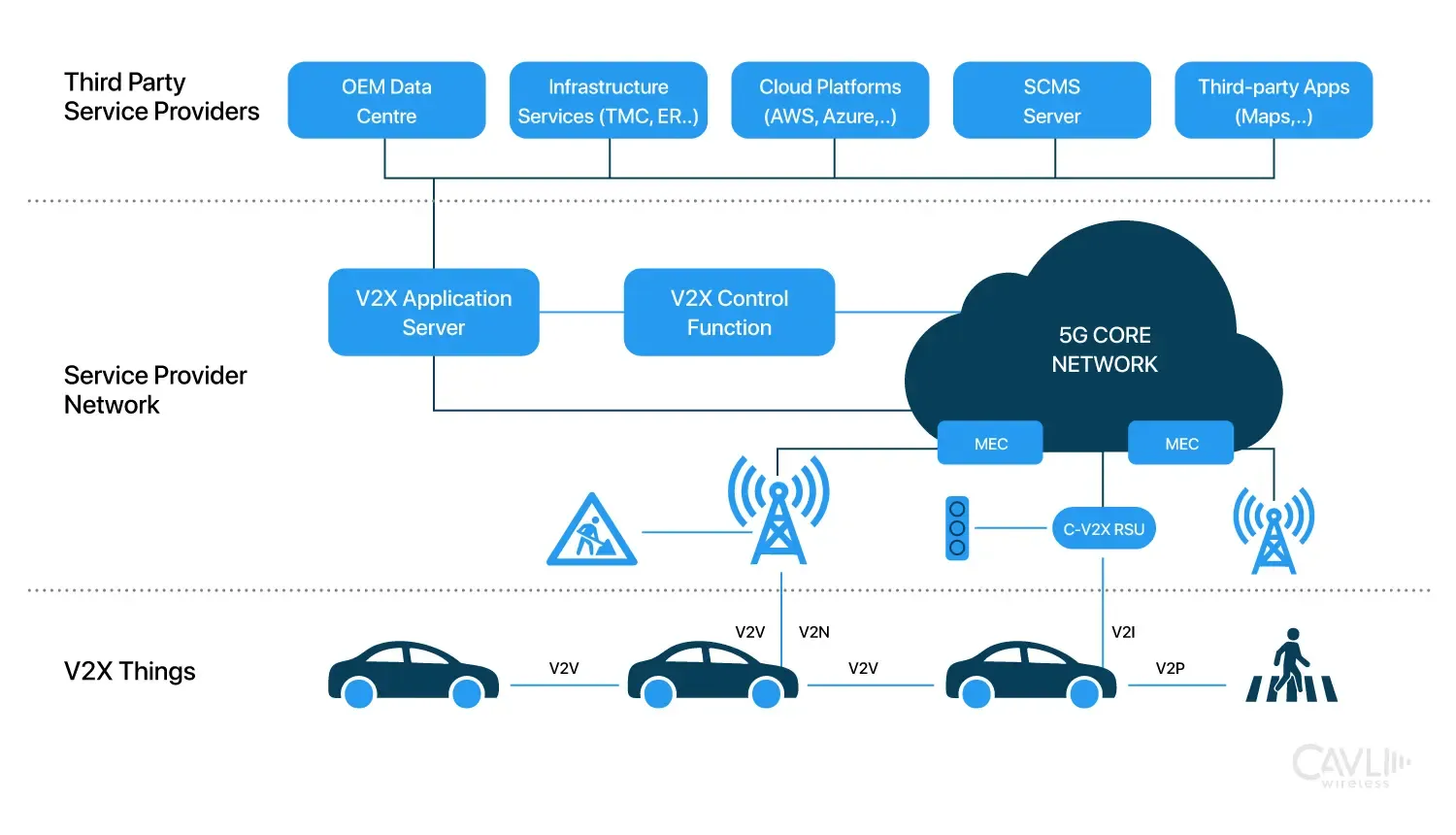James, Jr. Automotive Engineer
Hey Adam, I've been hearing a lot about C-V2X lately, especially with the recent industry shift away from DSRC, the older Dedicated Short-Range Communications protocol that was initially developed for vehicle-to-vehicle communications. What makes C-V2X so special for connected vehicles?
Adam, Sr. Connected Vehicle Engineer
C-V2X is truly transformative for connected vehicles. Unlike DSRC, it offers both direct short-range communications and cellular network connectivity. C-V2X supports dual-mode operation, which allows for both direct short-range communication (in the PC5 mode) and longer-range communication through cellular networks (in the Uu mode). This dual capability allows vehicles to communicate directly with each other even in areas without cellular coverage, while also taking advantage of the broader range, higher bandwidth, and cloud services offered by 4G and 5G networks.
James, Jr. Automotive Engineer
That’s interesting! So what does Cellular V2X offer when compared to DSRC? How is it better?
Adam, Sr. Connected Vehicle Engineer
Good question! One of the key advantages of C-V2X over DSRC is its ultra-low latency, which is crucial for time-sensitive safety applications like collision warnings and emergency braking. C-V2X can achieve sub-20 millisecond latency for direct communications, making it fast and reliable. It also uses dedicated spectrum in the 5.9 GHz band and has advanced Quality of Service (QoS) features to prioritize safety-critical messages. Additionally, C-V2X’s ability to integrate with 4G and 5G vehicle communication allows it to support more advanced use cases and scalability in dense traffic environments where many vehicles are communicating at once.
James, Jr. Automotive Engineer
Are we seeing actual cellular vehicle-to-everything implementations yet? What about real-world deployment implications?
Adam, Sr. Connected Vehicle Engineer
It's definitely moving beyond theory! Major automakers are already implementing C-V2X auto technology in their newer models, and several cities are deploying C-V2X-enabled infrastructure. China's been particularly aggressive with deployment, and we're seeing increasing adoption in Europe and North America. The technology is proving especially valuable for advanced driver assistance systems and laying the groundwork for autonomous vehicles. Let me walk you through how it all works in detail.
As the automotive industry races toward a connected future, C-V2X (Cellular Vehicle-to-Everything) technology emerges as an anchor of intelligent transportation systems. With Adam and James’ insightful conversation setting the stage, it’s clear that C-V2X is making its mark beyond theory, into real-world applications. Let’s take a deeper dive into how C-V2X technology is driving the evolution of vehicle- to-vehicle communication, reshaping transportation infrastructure, and paving the way for future mobility solutions.
What is C-V2X Communication?
Cellular Vehicle-to-Everything, C-V2X technology is a framework that enables direct and network-based interaction between vehicles, roadside infrastructure, and with other road users through cellular networks.
In June 2017, the 3rd Generation Partnership Project (3GPP) finalized C-V2X technology as part of its Release 14 standards. C-V2X is designed to enhance vehicle safety and provide real-time information, facilitating the creation of Cooperative Intelligent Transport Systems (C-ITS). This advancement aims to alleviate traffic congestion, reduce emissions, and improve overall travel efficiency, paving the way for smarter and more connected transportation networks.
Different Types of C-V2X Communications
V2V (Vehicle-to-Vehicle) Communication
Vehicle-to-Vehicle communication represents a revolutionary advancement in automotive safety and efficiency. This system enables vehicles to share comprehensive data about their current state, including detailed position information, velocity vectors, and directional heading. These capabilities facilitate sophisticated collision avoidance systems and enable cooperative driving scenarios. Advanced implementations support vehicle platooning, where multiple vehicles coordinate their movements to improve aerodynamics and fuel efficiency, while cooperative adaptive cruise control systems use this shared information to maintain optimal spacing and speed.
V2I (Vehicle-to-Infrastructure) Communication
Vehicle-to-Infrastructure communication creates a seamless connection between vehicles and the surrounding transportation infrastructure. This system provides real-time updates about traffic signal timing and phasing information, enabling vehicles to optimize their approach to intersections. The infrastructure network continuously monitors and broadcasts critical updates about road conditions and severe weather warnings. Additionally, this communication channel enables dynamic routing capabilities and sophisticated traffic management systems that can adapt to changing conditions in real-time.
V2P (Vehicle-to-Pedestrian) Communication
Vehicle-to-Pedestrian communication introduces a new layer of safety for vulnerable road users. The system continuously monitors for pedestrian presence and movement patterns, providing advanced warning systems to both vehicles and pedestrians. This technology enables sophisticated protection mechanisms for vulnerable road users, including cyclists and mobility-impaired individuals. The integration with smart crosswalk systems creates a comprehensive safety network that actively prevents accidents and enhances pedestrian security.
V2N (Vehicle-to-Network) Communication
Vehicle-to-Network communication extends the capabilities of connected vehicles into the cloud and broader digital infrastructure. This system enables access to sophisticated cloud-based services and ensures vehicles maintain current software and safety systems through regular updates. Vehicles receive continuous streams of navigation data and real-time traffic information, allowing for optimal route planning and congestion avoidance. The network connection also supports advanced entertainment and infotainment services, enhancing the overall driving experience.
C-V2X Architecture: How Cellular V2X Communication Works
C-V2X technology builds upon cellular communications standards set by the 3rd Generation Partnership Project (3GPP) to create a robust vehicular communication system.
C-V2X architecture operates through two communication modes: direct short-range (PC5) for real-time safety applications and network-based (Uu) for broader coverage using 4G /5G. This dual capability enhances road safety, traffic efficiency, and enables advanced driving assistance and autonomous vehicle functions.

The PC5 interface serves as the foundation for direct communication between vehicles, pedestrians, and infrastructure, enabling immediate data exchange without network dependency. It enables instantaneous peer-to-peer communication without relying on network infrastructure. C-V2X operates in direct mode within the 5.9 GHz ITS (Intelligent Transport Systems) band, a frequency range established to facilitate communication between vehicles.
The 5.9 GHz band is shared with 802.11p, also known as DSRC (Dedicated Short-Range Communications), which was previously established for vehicle-to-vehicle communication. This overlap underscores the transition from DSRC to C-V2X, allowing continued use of the established ITS frequency.
Meanwhile, the Uu Interface facilitates network-based communications (V2N) through cellular infrastructure, providing broader coverage and additional services. It leverages existing cellular infrastructure to facilitate broader communication capabilities. It connects with cloud platforms and IoT devices such as roadside units (RSUs), traffic sensors, and pedestrian devices. This interaction supports a range of smart city applications, real-time traffic monitoring, and centralized data analysis.

C-V2X communication on the PC5 interface relies on the lower IoT layers like:
PHY (Physical Layer)
The PHY layer is responsible for the modulation and transmission of data over the air interface. In C-V2X, the PHY layer ensures that communication remains stable even under high vehicle speeds and Doppler conditions.
MAC (Medium Access Control Layer)
The MAC layer governs how different devices share access to the communication medium. In C-V2X, the MAC layer uses a sensing-based mechanism to reduce interference in dense traffic scenarios.
RLC (Radio Link Control Layer)
The RLC layer manages error correction and the delivery order of data packets, improving the reliability of data transmission.
PDCP (Packet Data Convergence Protocol Layer)
The PDCP layer handles data encryption, header compression, and reordering for data transmitted between devices.
The C-V2X protocol stack also integrates several higher-layer protocols and services that align with IoT frameworks, enabling advanced functionalities. These include:
Network Layer
C-V2X employs IPv6, enabling broader Internet-of-Things (IoT) connectivity and support for diverse applications.
Application Layer
This layer facilitates the processing of application-specific messages like Basic Safety Messages (BSM), emergency braking alerts, and infrastructure status updates. Protocols such as SAE J2735 and ETSI ITS-G5 are commonly used to define these messages.
Security Protocols
To ensure secure communication, C-V2X auto technology employs security mechanisms defined in IEEE 1609.2 and ETSI standards. These mechanisms enable data integrity, authentication, and encryption to prevent unauthorized access and tampering.
To learn more about other IoT layers and its functioning in IoT systems, refer to our blog on Architecture of IoT

The C-V2X ecosystem relies on several sophisticated components working in harmony. On-Board Units (OBUs) serve as the primary communication hub within vehicles, managing all C-V2X transmissions and data processing. These units work in conjunction with Roadside Units (RSUs), which are sophisticated pieces of infrastructure equipment that broadcast essential messages and coordinate traffic flow throughout the transportation network. Advanced application processors form the brain of the system, and handle complex data analysis. The entire system is protected by comprehensive security modules that maintain communication integrity through robust authentication and encryption protocols.
C-V2X Applications and Use Cases
Platooning
C-V2X enables vehicles to form automated convoys that maintain closer distances between them than would be possible with human drivers. This coordinated formation saves road space, reduces fuel consumption, and improves the efficiency of goods transport. In platooning scenarios, C-V2X provides real-time vehicle-to-vehicle communication, ensuring synchronized braking and acceleration.
Cooperative Driving
Through vehicle-to-vehicle (V2V) communication, C-V2X facilitates coordinated maneuvers in dense traffic. Vehicles can convey their intent, such as merging into a lane or overtaking, to other road users, enabling smoother traffic flow and reducing sudden braking events.
Queue Warnings and Hazard Detection
Roadside infrastructure equipped with C-V2X can transmit warnings about upcoming queues, roadworks, or other hazards. This proactive communication helps vehicles slow down smoothly and avoid abrupt braking. Moreover, if a vehicle detects road hazards like icy patches, it can share this information with other vehicles in the vicinity, thereby enhancing collective situational awareness.
Collision Avoidance
C-V2X allows vehicles to continuously broadcast their position, speed, and direction. Onboard systems can process this data to identify potential collision risks and take preventive actions such as braking or accelerating. This proactive safety mechanism is particularly effective in mitigating accidents caused by driver error or inattention.
Traffic Efficiency
C-V2X technology revolutionizes traffic management through intelligent coordination systems. The Green Light Optimal Speed Advisory system calculates and suggests optimal vehicle speeds to maximize the likelihood of encountering green lights, reducing unnecessary stops and starts. Cooperative adaptive cruise control systems enable vehicles to maintain optimal spacing and speed based on real-time traffic conditions and neighboring vehicle behaviors.
Autonomous Driving Support
Real-time high-definition maps ensure that autonomous vehicles always operate with the current environmental information. Sophisticated sensor data sharing mechanisms enable vehicles to extend their perception beyond their immediate vicinity. Cooperative perception systems combine data from multiple vehicles and infrastructure sensors to create a comprehensive view of traffic conditions. Advanced path planning and coordination algorithms enable smooth interaction between autonomous and human-driven vehicles in mixed traffic scenarios.
Smart City Integration
C-V2X technology serves as a foundational element in modern smart city infrastructure. Intelligent traffic management systems adapt to real-time conditions, optimizing traffic flow across entire urban areas. Emergency response coordination becomes more efficient through direct communication channels between emergency vehicles, traffic infrastructure, and other road users.
Safety Applications
Forward Collision Warning
Forward collision warning systems leverage real-time data exchange between vehicles to predict and prevent potential accidents before they occur.
Intersection Movement Assistance
Intersection movement assistance technology coordinates vehicle movements through complex junctions, significantly reducing the risk of collisions at these high-risk locations.
Emergency Vehicle Approaching Warning
Emergency vehicle approaching warning systems create virtual corridors through traffic, enabling faster response times for emergency services.
Wrong-Way Driver Alert
The wrong-way driver alert system provides immediate notification to all nearby vehicles when erratic or dangerous driving patterns are detected, enabling proactive accident prevention.
Role of 5G in C-V2X Communication
5G NR C-V2X was standardized by the 3rd Generation Partnership Project (3GPP) in Release 16, which was completed in July 2020. Release 16 built upon the initial C-V2X framework established in Release 14 (which focused on LTE-based communication) by introducing New Radio (NR)-based C-V2X, leveraging 5G vehicle communication capabilities such as ultra-low latency, high reliability, and greater capacity to support advanced vehicle-to-vehicle communication and autonomous driving.

Key Features and Benefits of C-V2X Communication
Perception Sharing
Sidelink (PC5) communication allows vehicles to exchange sensor data directly without needing network coverage. Vehicles can share real-time information about road conditions, obstacles, and traffic scenarios with other vehicles in close proximity. This collaborative perception enables each vehicle to build a more comprehensive understanding of its surroundings, extending beyond what its own sensors can detect.
Path Planning
By leveraging both Sidelink and Uu communication, autonomous vehicles can receive real-time updates and coordinate their paths dynamically. This is crucial for smooth lane changes, merging, and adjusting to changing traffic conditions. For example, vehicles can communicate their intended actions to each other, reducing the risk of sudden stops or accidents.
Real-Time Local Updates
The Uu interface provides broader network-based communication, enabling vehicles to receive real-time updates from infrastructure and cloud services. This can include 3D HD map updates, alerts on traffic jams or road construction, and dynamic routing based on live data. It ensures that vehicles always have the most accurate and current information to navigate efficiently.
Coordinated Driving
5G C-V2X supports cooperative maneuvers like platooning and synchronized braking, where multiple vehicles move together with minimal human intervention. The combination of Sidelink and Uu communication facilitates coordinated driving at a large scale, improving traffic flow and reducing fuel consumption.
Role of Edge Computing in C-V2X Technology
Edge computing plays a crucial role in enabling 5G C-V2X to achieve its potential for supporting connected and autonomous vehicles. By processing data closer to the source, edge computing addresses several challenges related to latency, bandwidth, and real-time decision-making in vehicle-to-everything communications.
Key Benefits of Edge Computing in C-V2X
Ultra-Low Latency and Real-Time Processing
In C-V2X communication, vehicles often rely on real-time information for safety-critical applications such as collision avoidance, lane merging, and intersection assistance. Edge computing brings data processing closer to the vehicles by deploying computational resources at the network’s edge (e.g., at cellular base stations or roadside units). This reduces the latency associated with sending data to a central cloud server, making it possible for vehicles to react instantly to changes in road conditions, traffic, or other hazards.
Localized Decision-Making
In scenarios such as urban intersections or high-speed highways, edge computing allows for localized decision-making based on real-time data analytics. For example, edge nodes can collect data from multiple vehicles and infrastructure sensors and analyze it to provide coordinated traffic management or collision alerts. This localized approach is crucial for quick responses and ensures reliable safety measures in high-density environments.
Bandwidth Optimization
With 5G C-V2X generating large amounts of data from various sources like cameras, LiDAR, radar, and real-time HD maps, transmitting all of this data to a central cloud could overwhelm the network. Edge computing processes much of this data locally, only sending summarized or essential information to centralized cloud servers. This helps to optimize bandwidth usage, minimizing network congestion and improving overall communication efficiency.
Enhanced Data Security and Privacy
Processing sensitive vehicle or road data at the edge instead of in centralized data centers also improves data security and privacy. For example, edge computing can handle data encryption and secure vehicle communications in real-time, reducing the risks associated with transmitting raw, sensitive data over public networks.
Seamless Integration with AI and Machine Learning
Edge computing is well-suited for deploying AI and machine learning algorithms that require real-time processing. By running AI models at the edge, cellular vehicles can benefit from predictive analytics, object recognition, and autonomous decision-making without needing constant, high-latency communication with a distant cloud. This is especially crucial for autonomous vehicles that need to make quick decisions based on multiple inputs from onboard and external sensors.
To learn more about the role of edge computing in IoT use cases, refer to our blog on edge computing
Amusing Tech Chronicles
Facts and Anecdotes Related to this Edition of Wireless By Design
The Urban Symphony
Think of C-V2X as a grand orchestra performing in a city. Each vehicle is like a musician, reading their sheet music (receiving data) and playing their instrument (transmitting information) in perfect harmony with others. The cellular network acts as the conductor, ensuring everyone stays in sync, while direct communication is like musicians making eye contact during a performance.
Nature's Network
C-V2X mirrors how a school of fish communicates and moves together. Just as fish use multiple senses to avoid collisions and move as one, vehicle-to-vehicle communication uses various communication methods to create a seamless, safe transportation ecosystem.
Air Traffic Control 2.0
Similar to how air traffic control manages hundreds of flights simultaneously, C-V2X coordinates countless vehicles. But unlike traditional air traffic control, C-V2X allows vehicles to communicate directly with each other while still maintaining central coordination when needed.
Go Beyond and Explore
What's the difference between LTE-V2X and 5G NR-V2X?
The evolution of vehicular communication standards presents two significant technological approaches. LTE-V2X represents the current deployment standard in the industry for cellular vehicle-to-everything, providing fundamental safety features and basic connectivity options for modern vehicles. While this technology successfully enables essential safety applications, it operates within the constraints of LTE technology, resulting in certain limitations regarding bandwidth availability and latency performance.
In contrast, NR-V2X emerges as the next-generation standard, building upon the foundations of 5G New Radio technology. This advanced system delivers significantly enhanced reliability metrics and substantially lower latency rates compared to its predecessor. The improved technical capabilities of 5G NR C-V2X enable support for more sophisticated use cases, including advanced autonomous driving features and complex cooperative vehicle maneuvers that require precise timing and coordination.
What are the key differences between C-V2X and DSRC?
C-V2X (Cellular Vehicle-to-Everything) and DSRC (Dedicated Short-Range Communication) are both technologies designed to enable vehicle-to-everything (V2X) communications, but they differ in several key areas:
Technology Basis and Standards: DSRC is based on the IEEE 802.11p Wi-Fi standard and operates in the 5.9 GHz band. It was developed specifically for V2X communication and has been around for over a decade. In contrast, C-V2X was developed by the 3GPP and introduced in Release 14 (LTE-based) and later enhanced in Release 16 (5G-based). C-V2X also uses the 5.9 GHz band but is built on cellular communication protocols.
Communication Modes: DSRC relies on a single communication mode for direct short-range communication (V2V and V2I). On the other hand, C-V2X offers dual modes of communication—direct communication (PC5/Sidelink) for short-range, low-latency interactions, and network communication (Uu) for broader, long-range communications via cellular networks.
Range, Scalability, and Coverage: DSRC is effective for short-range communication but has limited range and scalability due to its reliance on Wi-Fi-like technology. C-V2X, with its integration into existing LTE and 5G networks, can scale better and provide coverage over a much larger area, making it more versatile.
Latency and Performance: Both technologies are designed for low-latency applications, but C-V2X (especially with 5G) offers significantly lower latency, higher bandwidth, and greater reliability, which are crucial for advanced autonomous driving applications and real-time data exchange.
Is V2X a part of ADAS?
V2X (Vehicle-to-Everything) and ADAS (Advanced Driver Assistance Systems) are distinct yet complementary technologies in the realm of automotive safety and automation. ADAS primarily relies on onboard sensors, such as cameras, radar, LiDAR, and ultrasonic sensors, to detect and respond to the immediate environment around a vehicle.
V2X, on the other hand, expands a vehicle’s situational awareness beyond what onboard sensors can provide. By enabling communication between vehicles (V2V), infrastructure (V2I), pedestrians (V2P), and the broader network (V2N), V2X systems can transmit real-time data on road conditions, traffic signals, and surrounding vehicles. This information helps cellular vehicles anticipate hazards or changes in traffic that are beyond the detection range of traditional ADAS sensors.
Thus, while ADAS focuses on localized detection and decision-making, V2X enhances these capabilities by providing a broader, network-driven context. V2X will play an essential role in enabling ADAS systems to become more intelligent and proactive.
What's the difference between V2G and V2X?
V2G (Vehicle-to-Grid): V2G specifically refers to the bidirectional flow of electricity between an electric vehicle (EV) and the power grid. It enables electric vehicles to not only draw power from the grid to charge their batteries but also to return stored energy back to the grid when needed. This capability allows EVs to act as mobile energy storage units, helping to balance grid demand, stabilize energy supply, and integrate renewable energy sources more effectively. V2G is primarily focused on optimizing energy consumption and management, making it a key component of smart grid and sustainable energy initiatives.
V2X (Vehicle-to-Everything): V2X, on the other hand, is a broader communication framework that encompasses various types of information exchange between a vehicle and its surroundings. It includes several communication types such as:
- V2V (Vehicle-to-Vehicle): Direct communication between vehicles to share real-time data like speed, location, and warnings.
- V2I (Vehicle-to-Infrastructure): Communication with roadside infrastructure like traffic signals and road signs.
- V2P (Vehicle-to-Pedestrian): Alerts exchanged between vehicles and pedestrians.
- V2N (Vehicle-to-Network): Connecting cellular vehicles to broader cloud services for updates and information.





